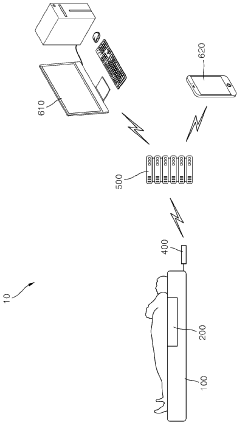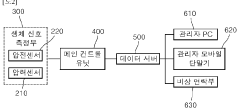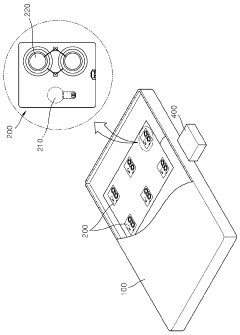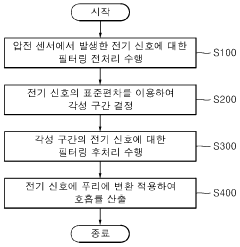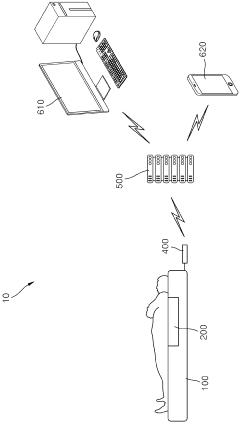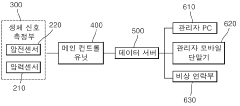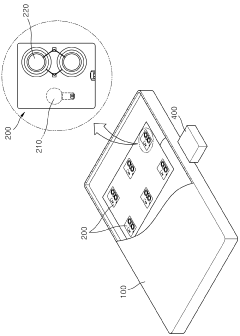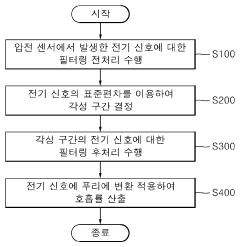Wearable Health Monitoring via Piezoelectric Sensors
JUL 17, 20259 MIN READ
Generate Your Research Report Instantly with AI Agent
Patsnap Eureka helps you evaluate technical feasibility & market potential.
Piezoelectric Sensing in Wearables: Background and Objectives
Piezoelectric sensing in wearable health monitoring devices represents a significant advancement in the field of personal healthcare technology. This innovative approach harnesses the unique properties of piezoelectric materials to create highly sensitive, flexible, and non-invasive sensors capable of detecting various physiological parameters. The development of these sensors has been driven by the growing demand for continuous health monitoring solutions that can seamlessly integrate into daily life.
The evolution of piezoelectric sensing technology in wearables can be traced back to the discovery of the piezoelectric effect by Jacques and Pierre Curie in 1880. However, it wasn't until recent decades that this phenomenon found practical applications in wearable health monitoring. The miniaturization of electronics, advancements in materials science, and the increasing focus on preventive healthcare have all contributed to the rapid progress in this field.
The primary objective of research in piezoelectric sensing for wearables is to develop robust, accurate, and user-friendly devices that can provide real-time health data to both users and healthcare professionals. These sensors aim to monitor a wide range of physiological parameters, including heart rate, blood pressure, respiratory rate, and even biochemical markers in sweat or other bodily fluids. The ultimate goal is to create a comprehensive health monitoring system that can detect early signs of health issues and facilitate timely interventions.
One of the key advantages of piezoelectric sensors in wearable health monitoring is their ability to generate electrical signals in response to mechanical stress or strain. This self-powered characteristic makes them particularly suitable for long-term, continuous monitoring applications. Additionally, their flexibility and thin-film form factor allow for comfortable integration into various wearable formats, such as smart watches, patches, or even clothing.
The current technological landscape sees piezoelectric sensors being employed in a variety of wearable health monitoring applications. These range from simple step counters and sleep trackers to more sophisticated devices capable of detecting subtle changes in gait patterns or monitoring cardiovascular health. The ongoing research aims to expand the capabilities of these sensors, improving their sensitivity, reliability, and the range of health parameters they can measure.
As the field progresses, researchers are exploring novel materials and fabrication techniques to enhance the performance of piezoelectric sensors. This includes the development of nanostructured piezoelectric materials, which offer improved sensitivity and flexibility. Furthermore, there is a growing focus on creating multi-modal sensing platforms that combine piezoelectric sensors with other sensing technologies to provide a more comprehensive health assessment.
The future of piezoelectric sensing in wearable health monitoring holds great promise. As the technology continues to mature, we can expect to see more sophisticated and integrated health monitoring solutions that seamlessly blend into our daily lives, potentially revolutionizing personal healthcare and preventive medicine.
The evolution of piezoelectric sensing technology in wearables can be traced back to the discovery of the piezoelectric effect by Jacques and Pierre Curie in 1880. However, it wasn't until recent decades that this phenomenon found practical applications in wearable health monitoring. The miniaturization of electronics, advancements in materials science, and the increasing focus on preventive healthcare have all contributed to the rapid progress in this field.
The primary objective of research in piezoelectric sensing for wearables is to develop robust, accurate, and user-friendly devices that can provide real-time health data to both users and healthcare professionals. These sensors aim to monitor a wide range of physiological parameters, including heart rate, blood pressure, respiratory rate, and even biochemical markers in sweat or other bodily fluids. The ultimate goal is to create a comprehensive health monitoring system that can detect early signs of health issues and facilitate timely interventions.
One of the key advantages of piezoelectric sensors in wearable health monitoring is their ability to generate electrical signals in response to mechanical stress or strain. This self-powered characteristic makes them particularly suitable for long-term, continuous monitoring applications. Additionally, their flexibility and thin-film form factor allow for comfortable integration into various wearable formats, such as smart watches, patches, or even clothing.
The current technological landscape sees piezoelectric sensors being employed in a variety of wearable health monitoring applications. These range from simple step counters and sleep trackers to more sophisticated devices capable of detecting subtle changes in gait patterns or monitoring cardiovascular health. The ongoing research aims to expand the capabilities of these sensors, improving their sensitivity, reliability, and the range of health parameters they can measure.
As the field progresses, researchers are exploring novel materials and fabrication techniques to enhance the performance of piezoelectric sensors. This includes the development of nanostructured piezoelectric materials, which offer improved sensitivity and flexibility. Furthermore, there is a growing focus on creating multi-modal sensing platforms that combine piezoelectric sensors with other sensing technologies to provide a more comprehensive health assessment.
The future of piezoelectric sensing in wearable health monitoring holds great promise. As the technology continues to mature, we can expect to see more sophisticated and integrated health monitoring solutions that seamlessly blend into our daily lives, potentially revolutionizing personal healthcare and preventive medicine.
Market Analysis for Piezoelectric Wearable Health Monitors
The market for piezoelectric wearable health monitors is experiencing significant growth, driven by increasing health consciousness and the rising prevalence of chronic diseases. This technology offers continuous, non-invasive monitoring of vital signs, making it particularly attractive for both consumer and medical applications.
In the consumer segment, fitness enthusiasts and health-conscious individuals are driving demand for wearable devices that can track various physiological parameters. The ability of piezoelectric sensors to measure heart rate, blood pressure, and respiratory rate without the need for bulky equipment has made them increasingly popular in smartwatches and fitness bands.
The medical sector represents another substantial market opportunity. Healthcare providers are showing growing interest in remote patient monitoring solutions, which can reduce hospital readmissions and improve patient outcomes. Piezoelectric wearable monitors offer a cost-effective means of continuous health tracking for patients with chronic conditions such as cardiovascular diseases and respiratory disorders.
Geographically, North America and Europe currently dominate the market due to advanced healthcare infrastructure and higher consumer spending on health technology. However, the Asia-Pacific region is expected to witness the fastest growth, fueled by improving healthcare access and rising disposable incomes in countries like China and India.
The global market for piezoelectric wearable health monitors is projected to expand at a compound annual growth rate (CAGR) of over 20% in the coming years. This growth is supported by technological advancements in sensor miniaturization and power efficiency, which are enabling the development of more comfortable and longer-lasting devices.
Key market players include established medical device manufacturers, consumer electronics giants, and innovative startups. These companies are investing heavily in research and development to improve sensor accuracy, expand the range of measurable health parameters, and enhance data analytics capabilities.
Despite the positive outlook, challenges remain. Privacy concerns regarding the collection and storage of personal health data need to be addressed. Additionally, regulatory hurdles in different regions may impact market growth, particularly for devices intended for medical use.
In conclusion, the market for piezoelectric wearable health monitors shows strong potential for growth across both consumer and medical applications. As technology continues to advance and healthcare systems increasingly embrace remote monitoring solutions, this market is poised for substantial expansion in the coming years.
In the consumer segment, fitness enthusiasts and health-conscious individuals are driving demand for wearable devices that can track various physiological parameters. The ability of piezoelectric sensors to measure heart rate, blood pressure, and respiratory rate without the need for bulky equipment has made them increasingly popular in smartwatches and fitness bands.
The medical sector represents another substantial market opportunity. Healthcare providers are showing growing interest in remote patient monitoring solutions, which can reduce hospital readmissions and improve patient outcomes. Piezoelectric wearable monitors offer a cost-effective means of continuous health tracking for patients with chronic conditions such as cardiovascular diseases and respiratory disorders.
Geographically, North America and Europe currently dominate the market due to advanced healthcare infrastructure and higher consumer spending on health technology. However, the Asia-Pacific region is expected to witness the fastest growth, fueled by improving healthcare access and rising disposable incomes in countries like China and India.
The global market for piezoelectric wearable health monitors is projected to expand at a compound annual growth rate (CAGR) of over 20% in the coming years. This growth is supported by technological advancements in sensor miniaturization and power efficiency, which are enabling the development of more comfortable and longer-lasting devices.
Key market players include established medical device manufacturers, consumer electronics giants, and innovative startups. These companies are investing heavily in research and development to improve sensor accuracy, expand the range of measurable health parameters, and enhance data analytics capabilities.
Despite the positive outlook, challenges remain. Privacy concerns regarding the collection and storage of personal health data need to be addressed. Additionally, regulatory hurdles in different regions may impact market growth, particularly for devices intended for medical use.
In conclusion, the market for piezoelectric wearable health monitors shows strong potential for growth across both consumer and medical applications. As technology continues to advance and healthcare systems increasingly embrace remote monitoring solutions, this market is poised for substantial expansion in the coming years.
Current Challenges in Piezoelectric Sensor Integration
The integration of piezoelectric sensors into wearable health monitoring devices presents several significant challenges that researchers and engineers are actively working to overcome. One of the primary obstacles is the miniaturization of sensor components while maintaining high sensitivity and accuracy. As wearable devices become increasingly compact and unobtrusive, there is a growing demand for smaller piezoelectric sensors that can still deliver reliable health data. This miniaturization process often leads to compromises in sensor performance, requiring innovative design solutions to maintain the quality of measurements.
Another critical challenge lies in the power management of piezoelectric sensor systems in wearable devices. While piezoelectric materials can generate electricity through mechanical stress, the amount of power produced is often insufficient to sustain continuous operation of the entire wearable device. This necessitates the development of ultra-low-power circuits and energy harvesting techniques to extend battery life and potentially enable self-powered operation. Balancing power consumption with sensor performance remains a delicate trade-off that engineers must carefully navigate.
The flexibility and conformability of piezoelectric sensors pose additional integration challenges. Wearable health monitors need to adapt to the contours of the human body and withstand constant movement without compromising sensor functionality. Developing flexible piezoelectric materials and substrates that can maintain their sensing capabilities under various deformations is an ongoing area of research. This challenge extends to the durability of the sensors, as they must withstand repeated bending, stretching, and exposure to environmental factors such as sweat and temperature variations.
Signal processing and noise reduction represent another set of hurdles in piezoelectric sensor integration. Wearable devices are subject to various sources of interference, including motion artifacts and electromagnetic noise from nearby electronic devices. Distinguishing genuine health signals from these disturbances requires sophisticated signal processing algorithms and hardware designs. Moreover, the integration of these processing capabilities into the limited space and power budget of wearable devices adds another layer of complexity to the challenge.
Biocompatibility and long-term stability of piezoelectric sensors in contact with the skin are also critical concerns. Materials used in these sensors must not cause irritation or allergic reactions, even with prolonged wear. Additionally, ensuring that the sensors maintain their calibration and performance over extended periods of use is essential for reliable health monitoring. This involves addressing issues such as sensor drift, degradation of piezoelectric materials, and the effects of repeated sterilization or cleaning processes on sensor integrity.
Another critical challenge lies in the power management of piezoelectric sensor systems in wearable devices. While piezoelectric materials can generate electricity through mechanical stress, the amount of power produced is often insufficient to sustain continuous operation of the entire wearable device. This necessitates the development of ultra-low-power circuits and energy harvesting techniques to extend battery life and potentially enable self-powered operation. Balancing power consumption with sensor performance remains a delicate trade-off that engineers must carefully navigate.
The flexibility and conformability of piezoelectric sensors pose additional integration challenges. Wearable health monitors need to adapt to the contours of the human body and withstand constant movement without compromising sensor functionality. Developing flexible piezoelectric materials and substrates that can maintain their sensing capabilities under various deformations is an ongoing area of research. This challenge extends to the durability of the sensors, as they must withstand repeated bending, stretching, and exposure to environmental factors such as sweat and temperature variations.
Signal processing and noise reduction represent another set of hurdles in piezoelectric sensor integration. Wearable devices are subject to various sources of interference, including motion artifacts and electromagnetic noise from nearby electronic devices. Distinguishing genuine health signals from these disturbances requires sophisticated signal processing algorithms and hardware designs. Moreover, the integration of these processing capabilities into the limited space and power budget of wearable devices adds another layer of complexity to the challenge.
Biocompatibility and long-term stability of piezoelectric sensors in contact with the skin are also critical concerns. Materials used in these sensors must not cause irritation or allergic reactions, even with prolonged wear. Additionally, ensuring that the sensors maintain their calibration and performance over extended periods of use is essential for reliable health monitoring. This involves addressing issues such as sensor drift, degradation of piezoelectric materials, and the effects of repeated sterilization or cleaning processes on sensor integrity.
Existing Piezoelectric Wearable Health Monitoring Solutions
01 Piezoelectric sensors for structural health monitoring
Piezoelectric sensors are used for monitoring the health and integrity of various structures. These sensors can detect vibrations, stress, and strain in buildings, bridges, and other infrastructure, providing real-time data on structural conditions and potential damage.- Piezoelectric sensors for structural health monitoring: Piezoelectric sensors are used for structural health monitoring in various applications. These sensors can detect and measure mechanical stress, vibrations, and deformations in structures, providing real-time data for assessing the integrity and safety of buildings, bridges, and other infrastructure.
- Wearable piezoelectric sensors for health monitoring: Wearable devices incorporating piezoelectric sensors are developed for continuous health monitoring. These sensors can measure various physiological parameters such as heart rate, blood pressure, and respiratory rate, enabling non-invasive and real-time health tracking for patients and fitness enthusiasts.
- Piezoelectric sensors in medical implants: Piezoelectric sensors are integrated into medical implants for monitoring various health parameters. These sensors can provide crucial data on implant performance, detect potential complications, and enable early intervention in cases of implant failure or patient health deterioration.
- Energy harvesting piezoelectric sensors for health monitoring: Energy harvesting piezoelectric sensors are developed for self-powered health monitoring systems. These sensors can generate electricity from body movements or environmental vibrations, enabling long-term, battery-free operation of health monitoring devices.
- Piezoelectric sensor arrays for comprehensive health assessment: Arrays of piezoelectric sensors are used for comprehensive health assessment. These sensor arrays can simultaneously monitor multiple health parameters and provide a more holistic view of an individual's health status, enabling early detection of potential health issues and personalized healthcare interventions.
02 Wearable piezoelectric sensors for health monitoring
Wearable devices incorporating piezoelectric sensors are developed for continuous health monitoring. These sensors can measure vital signs, physical activity, and other physiological parameters, enabling non-invasive and real-time health tracking for individuals.Expand Specific Solutions03 Piezoelectric sensors in medical implants
Piezoelectric sensors are integrated into medical implants for monitoring various health parameters. These sensors can provide continuous data on implant performance, surrounding tissue conditions, and patient health status, improving the effectiveness of implantable medical devices.Expand Specific Solutions04 Energy harvesting piezoelectric sensors for health applications
Energy harvesting piezoelectric sensors are developed for self-powered health monitoring devices. These sensors can generate electricity from body movements or environmental vibrations, enabling long-term operation of health monitoring systems without the need for frequent battery replacements.Expand Specific Solutions05 Piezoelectric sensor arrays for comprehensive health assessment
Arrays of piezoelectric sensors are used for comprehensive health assessment. These sensor arrays can simultaneously monitor multiple health parameters, providing a more complete picture of an individual's health status and enabling early detection of potential health issues.Expand Specific Solutions
Key Players in Piezoelectric Wearable Health Monitoring
The research on wearable health monitoring via piezoelectric sensors is in a growth phase, with increasing market size and technological advancements. The global wearable health monitoring market is expanding rapidly, driven by rising health awareness and demand for remote patient monitoring. Companies like Masimo Corp. and Huawei Technologies are leading innovation in this field, developing advanced sensors and integrated health monitoring devices. Universities such as the University of Michigan and Huazhong University of Science & Technology are contributing to fundamental research, while companies like LG Innotek and Jabil are focusing on manufacturing and commercialization. The technology is maturing, with improvements in sensor accuracy, power efficiency, and data analytics, but challenges remain in miniaturization and long-term reliability.
Masimo Corp.
Technical Solution: Masimo has developed advanced piezoelectric sensor technology for wearable health monitoring. Their approach utilizes flexible piezoelectric materials integrated into comfortable wearable devices. These sensors can detect subtle physiological signals such as heart rate, respiration, and blood oxygen levels with high accuracy[1]. Masimo's proprietary signal processing algorithms filter out motion artifacts and ambient noise, ensuring reliable measurements even during patient movement[2]. The company has also implemented wireless connectivity in their devices, allowing for real-time data transmission to healthcare providers and integration with electronic health record systems[3].
Strengths: High accuracy in physiological measurements, advanced signal processing for noise reduction, seamless integration with healthcare systems. Weaknesses: Potential higher cost compared to simpler wearables, may require periodic calibration for optimal performance.
Hill-Rom Services, Inc.
Technical Solution: Hill-Rom has developed a specialized wearable health monitoring system using piezoelectric sensors, primarily focused on hospital and clinical settings. Their approach integrates piezoelectric sensors into hospital beds, patient gowns, and portable monitoring devices. These sensors can continuously monitor patient vital signs, movement, and position without the need for wired connections[8]. Hill-Rom's system employs advanced signal processing techniques to filter out environmental noise and patient movement artifacts, ensuring accurate measurements even in busy clinical environments. The company has also implemented a centralized monitoring platform that allows healthcare providers to track multiple patients simultaneously, with automated alerts for any significant changes in patient condition[9]. Hill-Rom's technology includes predictive analytics capabilities, using historical data to identify potential health risks and suggest preventive measures.
Strengths: Specialized for clinical environments, centralized monitoring capabilities, predictive analytics for risk assessment. Weaknesses: May be less suitable for consumer applications, potentially higher cost due to medical-grade requirements.
Core Innovations in Piezoelectric Sensing for Wearables
Health monitoring system using piezoelectric sensor
PatentWO2024117344A1
Innovation
- A health monitoring system utilizing a mattress embedded with piezoelectric sensors that measures cardiac ballistics to detect breathing and heart rates without the need for wearable devices, using a bio-signal measuring unit with pressure sensors to ensure accurate and continuous monitoring, even in an unconscious state, and automatically transmitting critical information to designated medical or firefighting institutions if necessary.
Health monitoring system using piezoelectric sensor
PatentPendingKR1020240080531A
Innovation
- A health monitoring system using a mattress embedded with piezoelectric sensors to measure cardiac ballistics, incorporating pressure sensors for presence detection and motion artifact removal, with a main control unit for data analysis and a data server for storing and transmitting health information to guardians or emergency services.
Energy Harvesting Potential of Piezoelectric Wearables
Piezoelectric wearables have shown significant potential for energy harvesting, offering a promising solution to power various health monitoring devices. This technology leverages the piezoelectric effect, which generates an electric charge in certain materials when subjected to mechanical stress or vibration. In the context of wearable health monitoring, piezoelectric sensors can harness energy from natural body movements, such as walking, breathing, or even heartbeats.
The energy harvesting capabilities of piezoelectric wearables are particularly advantageous for long-term health monitoring applications. These devices can potentially operate autonomously, reducing or eliminating the need for battery replacements or frequent charging. This self-powering feature is crucial for continuous health monitoring, especially in remote or resource-limited settings where regular access to power sources may be challenging.
Recent advancements in materials science and nanofabrication techniques have significantly improved the efficiency of piezoelectric energy harvesters. Researchers have developed flexible and stretchable piezoelectric materials that can conform to the body's contours, maximizing energy capture from various movements. For instance, piezoelectric fibers integrated into clothing can harvest energy from the wearer's daily activities, while thin-film piezoelectric patches can be directly applied to the skin to capture energy from subtle physiological processes.
The amount of energy that can be harvested varies depending on the type of movement and the design of the piezoelectric device. Studies have shown that piezoelectric wearables can generate power in the range of microwatts to milliwatts, which is sufficient to operate low-power sensors and wireless communication modules commonly used in health monitoring devices. For example, a piezoelectric shoe insole has been demonstrated to generate up to 20 mW of power during normal walking, enough to power a small wireless transmitter.
Moreover, the integration of piezoelectric energy harvesters with other energy harvesting technologies, such as thermoelectric or photovoltaic systems, can create hybrid power sources that enhance the overall energy output and reliability of wearable health monitoring devices. This multi-modal approach can ensure a more consistent power supply across various user activities and environmental conditions.
However, challenges remain in optimizing the energy conversion efficiency and durability of piezoelectric wearables for long-term use. Ongoing research focuses on developing more efficient piezoelectric materials, improving energy storage solutions, and designing power management circuits that can effectively utilize the harvested energy. As these technologies continue to advance, piezoelectric wearables are poised to play a crucial role in enabling self-powered, continuous health monitoring systems, potentially revolutionizing personal healthcare and remote patient monitoring.
The energy harvesting capabilities of piezoelectric wearables are particularly advantageous for long-term health monitoring applications. These devices can potentially operate autonomously, reducing or eliminating the need for battery replacements or frequent charging. This self-powering feature is crucial for continuous health monitoring, especially in remote or resource-limited settings where regular access to power sources may be challenging.
Recent advancements in materials science and nanofabrication techniques have significantly improved the efficiency of piezoelectric energy harvesters. Researchers have developed flexible and stretchable piezoelectric materials that can conform to the body's contours, maximizing energy capture from various movements. For instance, piezoelectric fibers integrated into clothing can harvest energy from the wearer's daily activities, while thin-film piezoelectric patches can be directly applied to the skin to capture energy from subtle physiological processes.
The amount of energy that can be harvested varies depending on the type of movement and the design of the piezoelectric device. Studies have shown that piezoelectric wearables can generate power in the range of microwatts to milliwatts, which is sufficient to operate low-power sensors and wireless communication modules commonly used in health monitoring devices. For example, a piezoelectric shoe insole has been demonstrated to generate up to 20 mW of power during normal walking, enough to power a small wireless transmitter.
Moreover, the integration of piezoelectric energy harvesters with other energy harvesting technologies, such as thermoelectric or photovoltaic systems, can create hybrid power sources that enhance the overall energy output and reliability of wearable health monitoring devices. This multi-modal approach can ensure a more consistent power supply across various user activities and environmental conditions.
However, challenges remain in optimizing the energy conversion efficiency and durability of piezoelectric wearables for long-term use. Ongoing research focuses on developing more efficient piezoelectric materials, improving energy storage solutions, and designing power management circuits that can effectively utilize the harvested energy. As these technologies continue to advance, piezoelectric wearables are poised to play a crucial role in enabling self-powered, continuous health monitoring systems, potentially revolutionizing personal healthcare and remote patient monitoring.
Biocompatibility and Safety Considerations
Biocompatibility and safety considerations are paramount in the development and implementation of wearable health monitoring devices utilizing piezoelectric sensors. These devices, designed for continuous contact with the human body, must adhere to stringent standards to ensure user safety and comfort while maintaining optimal functionality.
The primary concern in biocompatibility is the potential for adverse reactions between the device materials and the user's skin or surrounding tissues. Piezoelectric sensors often incorporate materials such as lead zirconate titanate (PZT) or polyvinylidene fluoride (PVDF), which must be carefully evaluated for their long-term effects on human health. Manufacturers must conduct extensive testing to assess potential allergic reactions, skin irritation, or toxicity resulting from prolonged exposure to these materials.
To mitigate biocompatibility risks, researchers are exploring alternative piezoelectric materials with improved biocompatibility profiles. For instance, zinc oxide (ZnO) and aluminum nitride (AlN) have shown promise as lead-free piezoelectric materials with reduced toxicity concerns. Additionally, the use of biocompatible coatings and encapsulation techniques can further enhance the safety of these devices by creating a barrier between the sensor materials and the user's skin.
Safety considerations extend beyond material compatibility to include electrical safety and electromagnetic interference (EMI). Piezoelectric sensors generate electrical signals, and proper insulation and grounding are essential to prevent any risk of electrical shock or interference with other medical devices. Manufacturers must comply with international standards such as IEC 60601-1 for medical electrical equipment to ensure the safety of their wearable health monitoring devices.
Another critical aspect of safety is the potential for mechanical irritation or injury. The design of wearable devices must account for user comfort and minimize the risk of skin abrasion or pressure-induced injuries during prolonged use. This involves careful consideration of device form factor, attachment methods, and flexibility to accommodate natural body movements.
Data security and privacy are also integral to the safety considerations of wearable health monitoring devices. As these devices collect sensitive health information, robust encryption and secure data transmission protocols must be implemented to protect user privacy and prevent unauthorized access to personal health data.
Regulatory compliance is a crucial component of ensuring the safety and biocompatibility of wearable health monitoring devices. Manufacturers must navigate complex regulatory landscapes, including obtaining FDA approval in the United States or CE marking in the European Union. These regulatory processes often require extensive documentation of biocompatibility testing, risk assessments, and clinical trials to demonstrate the safety and efficacy of the devices.
The primary concern in biocompatibility is the potential for adverse reactions between the device materials and the user's skin or surrounding tissues. Piezoelectric sensors often incorporate materials such as lead zirconate titanate (PZT) or polyvinylidene fluoride (PVDF), which must be carefully evaluated for their long-term effects on human health. Manufacturers must conduct extensive testing to assess potential allergic reactions, skin irritation, or toxicity resulting from prolonged exposure to these materials.
To mitigate biocompatibility risks, researchers are exploring alternative piezoelectric materials with improved biocompatibility profiles. For instance, zinc oxide (ZnO) and aluminum nitride (AlN) have shown promise as lead-free piezoelectric materials with reduced toxicity concerns. Additionally, the use of biocompatible coatings and encapsulation techniques can further enhance the safety of these devices by creating a barrier between the sensor materials and the user's skin.
Safety considerations extend beyond material compatibility to include electrical safety and electromagnetic interference (EMI). Piezoelectric sensors generate electrical signals, and proper insulation and grounding are essential to prevent any risk of electrical shock or interference with other medical devices. Manufacturers must comply with international standards such as IEC 60601-1 for medical electrical equipment to ensure the safety of their wearable health monitoring devices.
Another critical aspect of safety is the potential for mechanical irritation or injury. The design of wearable devices must account for user comfort and minimize the risk of skin abrasion or pressure-induced injuries during prolonged use. This involves careful consideration of device form factor, attachment methods, and flexibility to accommodate natural body movements.
Data security and privacy are also integral to the safety considerations of wearable health monitoring devices. As these devices collect sensitive health information, robust encryption and secure data transmission protocols must be implemented to protect user privacy and prevent unauthorized access to personal health data.
Regulatory compliance is a crucial component of ensuring the safety and biocompatibility of wearable health monitoring devices. Manufacturers must navigate complex regulatory landscapes, including obtaining FDA approval in the United States or CE marking in the European Union. These regulatory processes often require extensive documentation of biocompatibility testing, risk assessments, and clinical trials to demonstrate the safety and efficacy of the devices.
Unlock deeper insights with Patsnap Eureka Quick Research — get a full tech report to explore trends and direct your research. Try now!
Generate Your Research Report Instantly with AI Agent
Supercharge your innovation with Patsnap Eureka AI Agent Platform!
